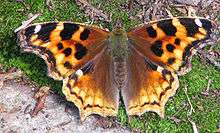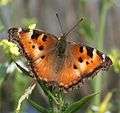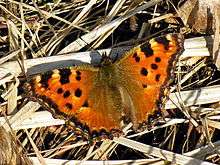Nymphalis
| Nymphalis | |
|---|---|
 | |
| Compton Tortoiseshell, N. vaualbum, Temagami, Ontario, Canada | |
| Scientific classification | |
| Kingdom: | Animalia |
| Phylum: | Arthropoda |
| Class: | Insecta |
| Order: | Lepidoptera |
| Family: | Nymphalidae |
| Subfamily: | Nymphalinae |
| Tribe: | Nymphalini |
| Genus: | Nymphalis Kluk, 1780[1] |
| Species | |
|
6 sp., see text | |
| Synonyms | |
|
Euvanessa Scudder, 1889 | |
Nymphalis, commonly known as Tortoiseshells,or Anglewing butterflies is a genus of brush-footed butterflies. The genera Aglais, Inachis, Polygonia, and Kaniska, were sometimes included as subgenera of Nymphalis[2] but they are by some people considered to be unique genera.[3] See also anglewing butterflies. For other butterflies named tortoiseshells, see the genus, Aglais.
The name Nymphalis Kluk, [1780][4] is the oldest name among the generic names for a relatively small group of butterflies collectively known as anglewing butterflies. In zoological nomenclature, the oldest name has a priority over other names. The collective name anglewing butterflies is derived from a Latinized term Papiliones angulati. This name was probably used for the first time by Ignaz Schiffermüller in 1775-1776. The anglewing butterflies as a group are characterized by a cryptic silhouete and by the colouration and pattern on the ventral side of both wings. This signature mark is an important taxonomic characteristic as well as a significant evolutionary adaptation.
During winter months, in latitudes with snow cover, all members of this group hibernate as adult butterflies.[5] During hibernation, hidden in various shelters, the butterflies are dormant. The camouflage provided by crypsis is obviously advantageous to hibernating butterflies. The potential predators will have difficulties in seeing the dormant butterflies. With their wings closed, exposing only the ventral cryptically coloured underside, they blend in with their surroundings.
Today, the anglewing butterflies are found only in the northern hemisphere. Since Linnaeus described the first members of this group in 1758, it is now clear (from the cumulative, total evidence recently obtained), that anglewing butterflies as group evolved from a common ancestor. The most recent studies include (Nylin et al., 2001; Wahlberg & Nylin, 2003; Wahlberg et al. 2011, 2009, 2005). The sister-group of Nymphalis is Vanessa.
Species
Listed alphabetically.[2]
- Nymphalis antiopa (Linnaeus, 1758) – Mourning Cloak or Camberwell Beauty
- Nymphalis californica (Boisduval, 1852) – California Tortoiseshell
- Nymphalis cyanomelas (Doubleday, [1848]) – Mexican Tortoiseshell
- Nymphalis polychloros (Linnaeus, 1758) – Large Tortoiseshell or Blackleg Tortoiseshell
- Nymphalis vaualbum ([Denis & Schiffermüller], 1775) – Compton Tortoiseshell or False Comma
- Nymphalis xanthomelas (Esper, 1781) – Scarce Tortoiseshell or Yellow-legged Tortoiseshell
Images of species
-

Mourning Cloak, Nymphalis antiopa
-

California Tortoiseshell, Nymphalis californica
-

Large Tortoiseshell, Nymphalis polychloros
-

Compton Tortoiseshell, Nymphalis vaualbum
-
_I_IMG_7043.jpg)
Scarce Tortoiseshell, Nymphalis xanthomelas
References
| Wikimedia Commons has media related to Nymphalis. |
| Wikispecies has information related to: Nymphalis |
- ↑ Nymphalis, ITIS Report
- 1 2 Nymphalis, funet.fi
- ↑ http://www.nhm.ac.uk/research-curation/research/projects/lepindex/ Lepindex
- ↑ Nymphalis Kluk, [1780]. – Hist. nat. pocz. gospod. 4: 86. – TS: Papilio polychloros Linnaeus, 1758 Systema Naturae (Edn. 10) 1: 477. Subsequently designated by Hemming (1933), The Entomologist 66: 223.
- ↑ Scott, J. A. (1999). Hibernal diapause of North American Papilionoidea and Hesperioidea. Journal of Research on the Lepidoptera 18(3):171-200.